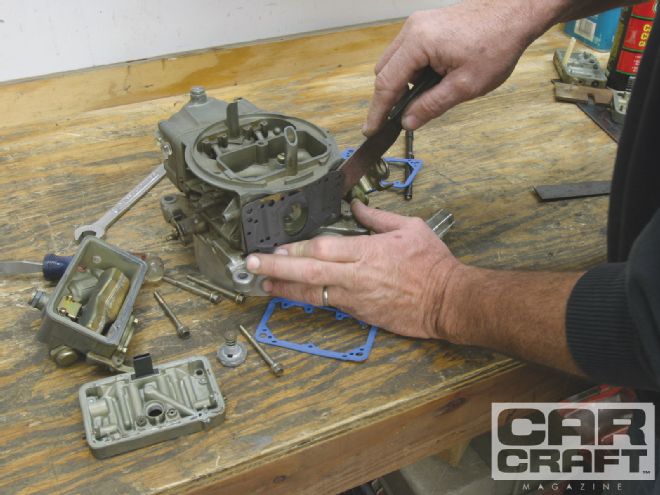
Sometime about 25 years ago, car magazines began doing stories on electronic fuel injection. They also began counting the days before carburetors would become extinct. Yet on the street today, the hot street-machine engine scales are still most definitely tipped in favor of the carburetor.
Holley Carburetor The overwhelming popular hero 50 years ago, as well as today, is the Holley carburetor, and it's probably a safe bet that will continue for at least the next 20 years. Many car crafters start out with a used Holley carburetor, so we thought a quick previously owned Holley carb drive-by might be a good thing, and maybe we'll add a few 21st century tweaks.
Pick a Winner Holley Carb
If you don't speak the Holley carb dialect, a few pointers may be in order. There are several ways to differentiate a Holley carb. We'll start with 4150 versus 4160 models. The classic 4150 uses a metering block on the secondary side, while the less expensive 4160 style uses a thinner metering plate. This difference also creates two dual-feed lengths, so keep that in mind when ordering a new fuel line. The other major way to identify a Holley carb is by the secondary actuation using either straight mechanical linkage or vacuum actuation in which velocity through the primary side of the carb creates enough signal to push a diaphragm against a small spring inside the vacuum housing to open the secondary side.
Holley also offers the broadest range of different size carburetors that are rated by airflow expressed in cubic feet per minute (CFM). The two most popular Holley carb sizes are the 600-cfm and 750-cfm versions but flow ratings range from 390 to 1250 cfm.
The Used Holley Shakedown
If you're looking for a used Holley carburetor, the swap meet is the place to go. At our most recent trip to Long Beach, California, the population density of Holley fuel mixers was at an all-time high. Prices seem to hover between $100 and $150 for all but the bigger-cfm carbs. There is an art to choosing a good carb, and since you can't test 'em, you may need a friend with a practiced eye to help spot the good ones. Holleys are pretty durable, so it's not difficult to find carburetors that are 20 to 40 years old. Any Holley with a small, linkage-actuated vent hole in the top of the primary fuel bowl is probably a '60s factory Chevrolet carb. The factory carbs can also be identified by a seven-digit sequence number on the choke housing. Another easy way to spot an older Holley is by the straight screwdriver blade float bowl screws. Later Holleys use a 5/16-inch hex bolt.
Look for a carb with matching bowls front and rear, with a color and appearance that is consistent. Mismatched bowls and/or metering blocks may be a sign that this carb has been assembled from the orphan carb parts bin and may be a questionable performer. Also look for broken or cracked base plates and missing small linkage pieces. These are usually good warning signs to look for a better unit. Take a quick glance at the air bleeds in the choke horn area to ensure that the carb has not been drilled by an overzealous "tuner." It's also best to recognize carb sizes by the Holley part number located on the choke horn. For example, the only difference between a 0-4779 750-cfm carb and its 0-4780 800-cfm cousin is a 1/16-inch larger secondary venturi diameter, so it's best to know the popular Holley list numbers in order to know their cfm ratings without having to ask. Car Craft family member Tim Moore has spent much of his life searching out good used Holleys, and we passed along some of his knowledge base.
Holley Hints, Tips, and Tricks
There are plenty of small changes that can turn a marginal carburetor into a crisp, throttle-responsive mix master that will have your buddies thinking you're some kind of carburetor wizard. The cold, hard truth is that just returning the carburetor to its stock jetting, accelerator pump squirter size, and other specs will, if anything, return the carb to a proper baseline for further tuning.
COMPONENT SPEC Primary jet 72 Secondary meter plate* 75 Power valve 6.5 Accelerator pump nozzle size 0.025 (0.031 w/-4 and newer) Secondary spring Plain Power valve channel restrictor 0.063 inch Idle feed restrictor diameter 0.032 0.034 inch
3310 Specs
These are the specs listed in the Holley catalog for all the 0-3310 vacuum-secondary carburetors. Most of the specs are the same for all the different models with a few exceptions, which are also listed.
PARTS LIST DESCRIPTION PN SOURCE PRICE Holley Renew kit 37-754 Summit Racing $32.95 Holley accelerator pump cam kit 20-12 Summit Racing 22.95 Holley vacuum-secondary spring kit 20-13 Summit Racing 11.95 Holley secondary meter block kit 34-13 Summit Racing 42.95 Holley quick-change cover kit 20-59 Summit Racing 15.95
Old-time carb guys use Chapstick on bowl and metering block gaskets to keep them from sticking.